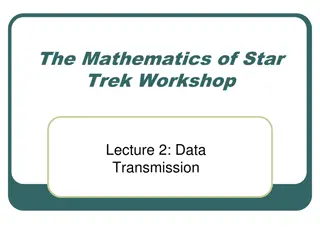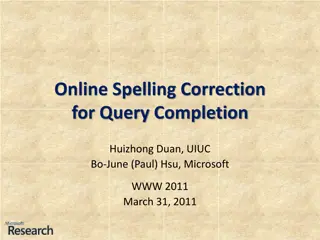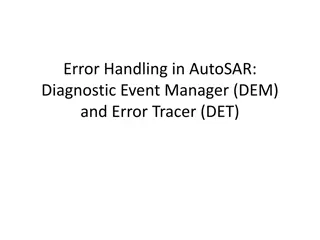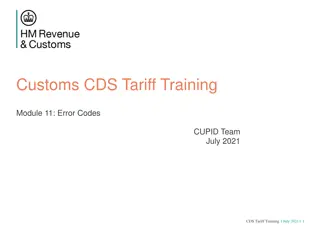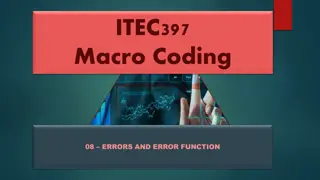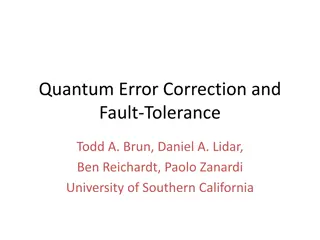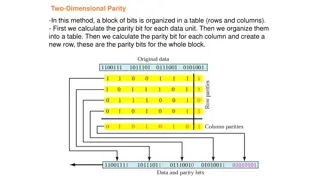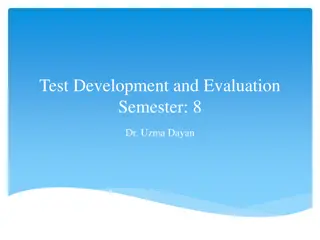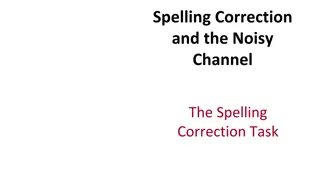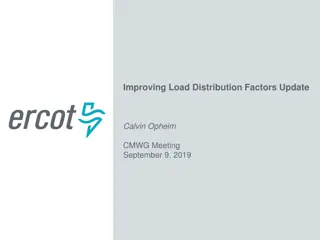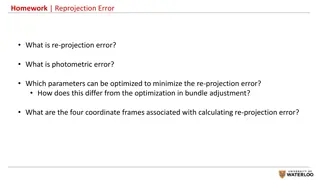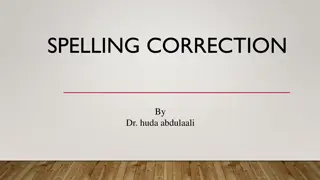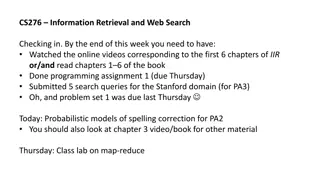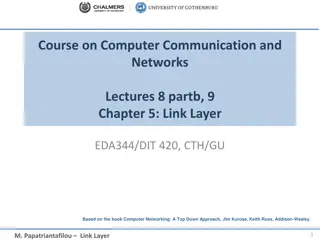Understanding Error Correction Techniques in Data Communication
Exploring the importance of error correction in data transmission, with insights on forward error correction, retransmission, Hamming distance, and minimum Hamming distance concepts. Learn how redundancies and algorithms help detect and correct errors in data units of varying sizes, ensuring reliable communication.
Uploaded on Jul 23, 2024 | 0 Views
Download Presentation

Please find below an Image/Link to download the presentation.
The content on the website is provided AS IS for your information and personal use only. It may not be sold, licensed, or shared on other websites without obtaining consent from the author. Download presentation by click this link. If you encounter any issues during the download, it is possible that the publisher has removed the file from their server.
E N D
Presentation Transcript
Error Correction We need to know the exact number of bits that are corrupted and more importantly, their locations in the message. The number of the errors and the size of the message are important factors. If we need to correct one single error in an 8-bit data unit, we need to consider 8 possible error locations. If we need to correct two errors in a data unit of the same size, we need to consider 28 possibilities. Imagine the receiver's difficulty in finding 10 errors in a data unit of 1000 bits. 1
Error Correction Techniques Forward Error Correction (FEC) In this process, the receiver tries to guess the message by using redundant bits. This is possible, if the number of errors is small. Retransmission A technique in which the receiver detects the occurrence of an error and asks the sender to resend the message. Resending is repeated until a message arrives that the receiver believes is error-free (usually, not all errors can be detected). 2
Example: Let us add 3 redundant bits to the 2-bit dataword to make 5-bit codewords. Table below shows the datawords and codewords. Assume the dataword is 01. The sender consults the table (or uses an algorithm) to create the codeword 01011. The codeword is corrupted during transmission, and 01001 is received (error in the second bit from the right). First, the receiver finds that the received codeword is not in the table. This means an error has occurred. (Detection must come before correction.) The receiver, assuming that there is only 1 bit corrupted, uses the following strategy to guess the correct dataword. 01001 3
1. Comparing the received codeword with the first codeword in the table (01001 versus 00000), the receiver decides that the first codeword is not the one that was sent because there are two different bits. 2. By the same reasoning, the original codeword cannot be the third or fourth one in the table. 3. The original codeword must be the second one in the table because this is the only one that differs from the received codeword by 1 bit. The receiver replaces 01001 with 01011 and consults the table to find the dataword 01. X 01001 X X 4
Hamming Distance The Hamming distance between two words (of the same size) is the number of differences between the corresponding bits. We show the Hamming distance between two words x and y as d(x, y). The Hamming distance can easily be found if we apply the XOR operation ( ) on the two words and count the number of 1s in the result. Note that the Hamming distance is a value greater than zero. d(x, y) > 0 Example: The Hamming distance d(000, 011) is 2. 000 011 is 011 (two 1s). The Hamming distance d(10101, 11110) is 3. 10101 11110 is 01011 (three 1s). 1. 2. 5
Minimum Hamming Distance The concept of the Hamming distance is the central point in dealing with error detection and correction codes. The measurement that is used for designing a code is the minimum Hamming distance. In a set of words, the minimum Hamming distance is the smallest Hamming distance between all possible pairs. We use dmin to define the minimum Hamming distance in a coding scheme. To find this value, we find the Hamming distances between all words and select the smallest one. 6
Example: Find the minimum Hamming distance of the coding scheme in below table. Solution: We first find all Hamming distances. d(000, 011) =2 d(000, 101) =2 d(011, 101) =2 d(011, 110) =2 d(000, 110) =2 d(101,110)=2 The dmin in this case is 2. 7
Example: Find the minimum Hamming distance of the coding scheme in below table. Solution: We first find all the Hamming distances. d(00000, 01011) = 3 d(01011, 10101) = 4 d(00000, 10101) = 3 d(01011, 11110) = 3 d(00000, 11110) = 4 d(10101, 11110) = 3 The dmin in this case is 3. 8
Three Parameters Any coding scheme needs to have at least three parameters: The codeword size n, The dataword size k, and The minimum Hamming distance dmin. A coding scheme C is written as C(n, k) with a separate expression for dmin. We can call our first coding scheme C(3, 2) with dmin =2 and our second coding scheme C(5, 2) with dmin = 3. 9
Hamming Distance and Error When a codeword is corrupted during transmission, the Hamming distance between the sent and received codewords is the number of bits affected by the error. In other words, the Hamming distance between the received codeword and the sent codeword is the number of bits that are corrupted during transmission. If the codeword 00000 is sent and 01101 is received, 3 bits are in error and the Hamming distance between the two is d(00000, 01101) =3. 10
Minimum Distance for Error Detection If s errors occur during transmission, the Hamming distance between the sent codeword and received codeword is s. If our code is to detect up to s errors, the minimum distance between the valid codes must be s + 1, so that the received codeword does not match a valid codeword. In other words, if the minimum distance between all valid codewords is s + 1, the received codeword can t be erroneously mistaken for another codeword. The distances are not enough (s + 1) for the receiver to accept it as valid. The error will be detected. 11
Example: The minimum Hamming distance for (table below) is 2. This code guarantees detection of only a single error. For example, if the third codeword (101) is sent and one error occurs, the received codeword does not match any valid codeword. If two errors occur, however, the received codeword may match a valid codeword and the errors are not detected. 12
Example: The minimum Hamming distance for (table below) is 3. This code can detect up to two errors. We see that when any of the valid codewords is sent, two errors create a codeword which is not in the table of valid codewords. The receiver cannot be fooled. However, some combinations of three errors change a valid codeword to another valid codeword. The receiver accepts the received codeword and the errors are undetected. 13
dmin = 2*t + 1 where t is the number of errors that can be corrected. If the minimum Hamming distance is 3, code can detect up to two errors and correct up to 1 error. 14
The Hamming distance between two words is the number of differences between corresponding bits. Example Let us find the Hamming distance between two pairs of words. 1. The Hamming distance d(000, 011) is 2 because 2. The Hamming distance d(10101, 11110) is 3 because 15
The minimum Hamming distance is the smallest Hamming distance between all possible pairs in a set of words. Example Find the minimum Hamming distance of the coding scheme in Table 1. Solution We first find all Hamming distances. The dmin in this case is 2. 16
Example Find the minimum Hamming distance of the coding scheme in Table 2. Solution We first find all the Hamming distances. The dmin in this case is 3. 18
To guarantee the detection of up to s errors in all cases, the minimum Hamming distance in a block code must be dmin = s + 1. To guarantee correction of up to t errors in all cases, the minimum Hamming distance in a block code must be dmin = 2t + 1. 19
Example A code scheme has a Hamming distance dmin = 4. What is the error detection and correction capability of this scheme? Solution This code guarantees the detection of up to three errors (s = 3), but it can correct up to one error. In other words, if this code is used for error correction, part of its capability is wasted. Error correction codes need to have an odd minimum distance (3, 5, 7, . . . ). 20


